Arsenal's spending power is growing but the actual spending still lags City and Liverpool
Some insights from the latest Deloitte Money League Report
There isn’t much going on in the January Transfer Window for Arsenal, so instead of analyzing a link to a player, I will look at another piece of information that came out this week, the Deloitte Football Money League 2025.
If you are interested in more player-focused analysis, I wrote up a film review session on the Norwegian wunderkind Sverre Halseth Nypan. It was a nice introduction to a player that I am sure only the hardest of hardcore watchers knew too much about.
Into the fun stuff now, accounting!
The headline of the money league report shows Arsenal making significant progress with another big jump in revenues. The 2023/24 season for Arsenal saw an increase of 35% in revenue for Arsenal.
This is largely driven by a big increase in broadcast revenues with the extra income that comes with moving up from the Europa League to the Champions League. There were increases in sponsorships/commercial and a bit less matchday revenues.
With this Arsenal overtook Liverpool last season in revenue taking the third spot for English teams, behind both Manchester Clubs.
Comparing Arsenal to Rivals
This report is also our first look at information that can shed a bit of light on how teams have spent the revenues that they generate. This is always a bit frustrating because official reporting is so delayed (often 18-20+ months behind) and the public sources for things like wages are so off to wonder if they are actually in the same ballpark to be true.
For this I am going to focus on Manchester City and Liverpool because they are the teams that Arsenal have been challenging at the very top of the table and I am going to ignore the rest for today.
Here is the high-level view of the teams from the Deloitte Report:
Arsenal have seen significant growth in their revenues over the last 5 seasons increasing from €388 million to €717 million, which is up 84%. Manchester City has seen similar growth going from €549 million to €838 million, which is up 53%. Liverpool haven’t seen the same level of revenue growth but are still up a solid amount going from €559 million to €715 million, which is up 28%.
The revenue gap for Arsenal has closed from €171 million to Liverpool to Arsenal just beating them, and from €161 million to Manchester City to €121 million.
There is still a gap to the top but the growth is impressive and gives hope that Arsenal can continue to use this financial might to try and compete.
Arsenal have spent to catch up
One of the repeated tropes online, especially in circles that might be skeptical (putting it nicely) about Mikel Arteta is to bring up what Arsenal have spent in the transfer market.
Under Mikel Arteta, Arsenal have spent €791.8 million according to Transfermarket and have spent €783.8 million since the start of the 2020/21 window. Those are large figures no doubt (often just said in pounds instead of Euros) and it was pretty clearly necessary to bring Arsenal from a pretty mediocre squad to where they are now.
Overall, Arsenal have spent the fifth most in absolute terms and fourth most in net terms.
These numbers however are above Manchester City on net spending and above Liverpool in both. This is often brought up with the critique that Arsenal haven’t delivered enough and used as an example of a problem for Arsenal because these teams competed well against Arsenal and often finished above them under Mikel Arteta.
There is definitely some truth that critique, Arsenal have not gotten every transfer right, and they have not always gotten “value” for the money spent on players that they have brought in but overall, the quality of the team has risen significantly and I would say that the transfer spending has been pretty comfortably better than average overall.
What this discussion often misses, and what I am glad to see in the report is the money spent on player wages.
Wages are a much stronger predictor of team strength and performance than spending in the transfer market, I have called it gravity because the way I see it and the data suggests teams can under or overperform their wages in the short term but they are almost always pulled back towards their level.
There is still a gap in wages
The latest report says that Arsenal spend 53% of their revenue on wages putting them at €380 million. For Manchester City it is 57% and €477 million, for Liverpool it is 63% and €450 million.
The gap in wages has shrunk but it is still pretty significant.
Overall, for the period that this covers in the Money League Manchester City have spent €2.1 billion in wages, Liverpool have spent €2.0 billion in wages, and Arsenal have spent €1.4 billion in wages.
So while Arsenal have spent more in the transfer market, especially net of sales, they have lagged behind their rivals in the metric that is more closely associated with success, wages.
This makes sense, Arsenal focused their recruitment on younger players that have developed over time. These are players that often come with a premium to acquire but have lower wages at the beginning of their contracts. As they prove their level the wages reflect their performance and will go up as they stay with the team longer. Arsenal were at the beginning of that cycle while Manchester City and Liverpool were already established at a very high level.
Final Thoughts
This type of look is always a nice check on the expectations. Soccer/Football is a sport where money is a huge factor and understanding where teams fit is important to having realistic expectations for things.
Arsenal have built an incredible team and the expectations are very high for them, they are still just the 7th richest team in the world and the third richest (basically tied for 4th) in their own country.
When you aren’t 1st or 2nd in your country it becomes very hard to win the biggest prizes. Even in the Champions League where there is more randomness, being in the top 5 goes a long way towards increasing your odds, with just Chelsea winning the Covid edition (8th) and Liverpool (7th) being outside of the top three in revenue to win the competition in the last decade.
Overcoming the systemic advantages that having more money causes is hard and it raises the level of difficulty for clubs like Arsenal and Liverpool who are rich, but just outside the elite of the rich teams.
Looking at the cumulative spending on wages and net spending in the transfer market for the three main Premier League clubs really shows this. Liverpool and Arsenal have spent a lot of money, but it still is well below what Manchester City have been able to do to maintain their spot at the top of the Premier League.
I remain optimistic about Arsenal’s ability to compete with the best teams in the world but they are still doing it with a higher degree of difficulty and lower margin for error to make mistakes.
Arsenal have taken strides to close the gap and get within touching distance of the biggest clubs and now it is a matter of whether they can close the last gaps or execute at a higher level to win the big trophies we want to see them lift.



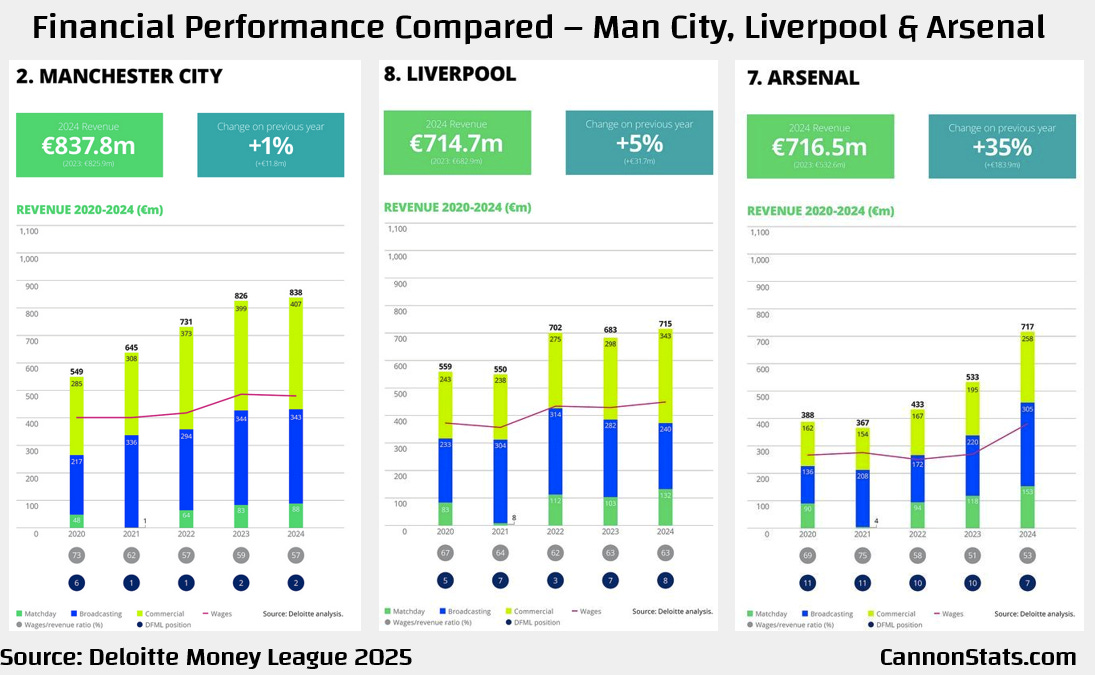
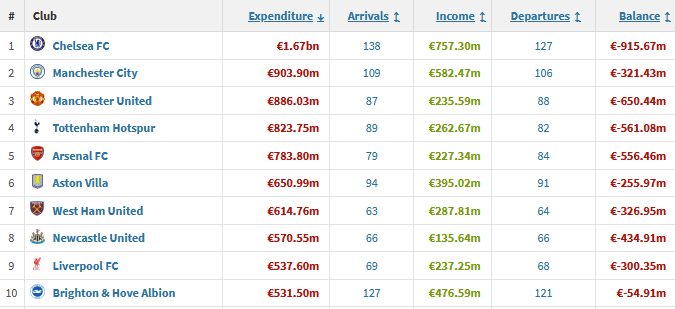
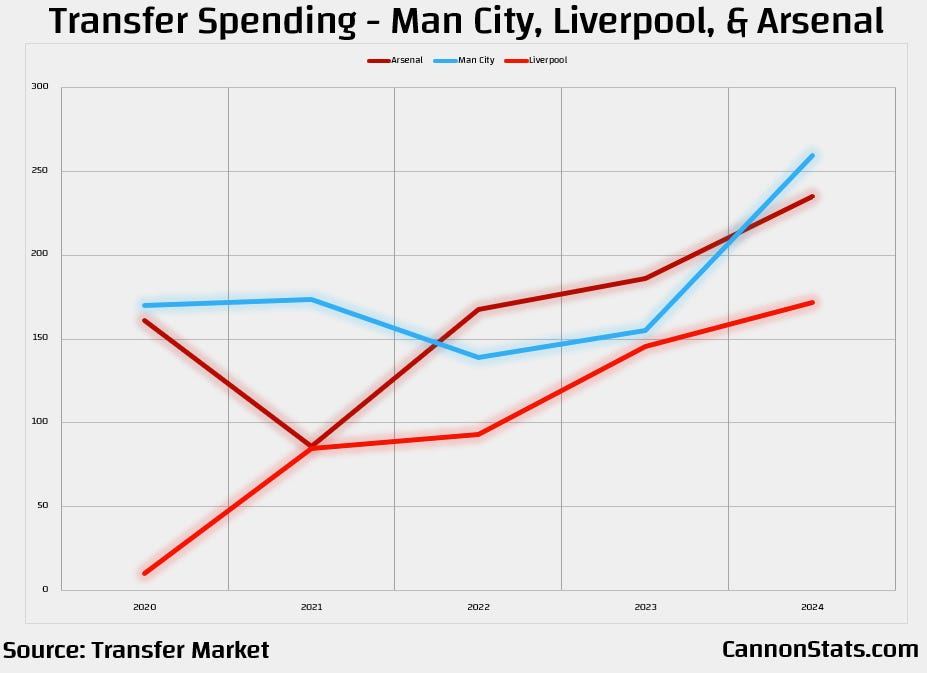
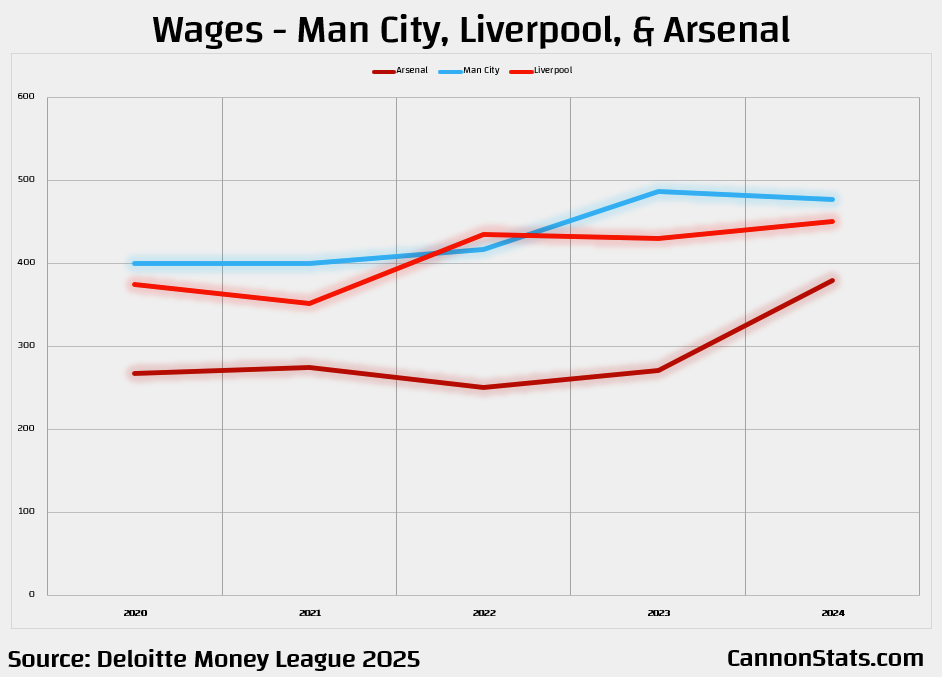
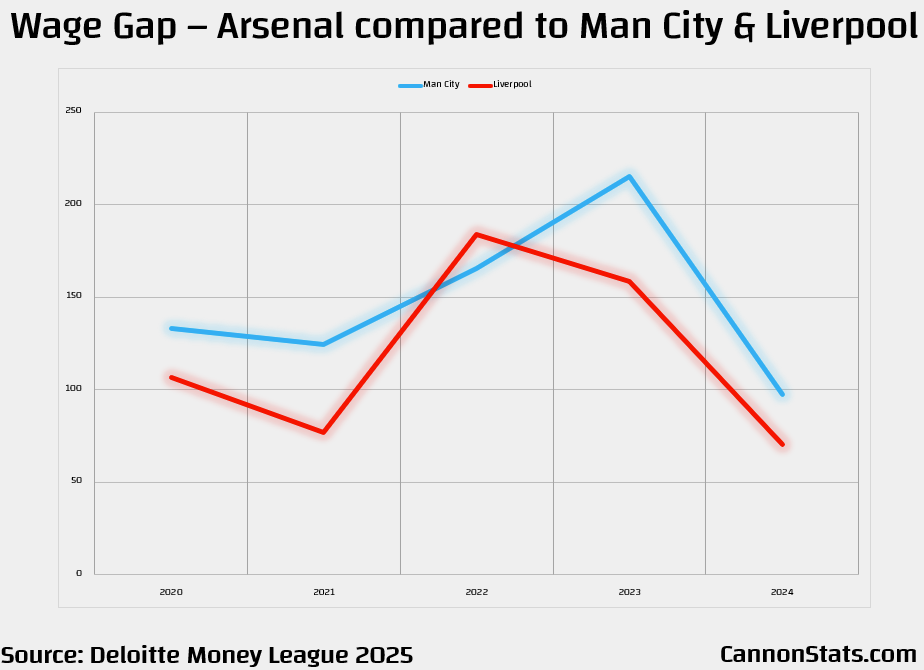
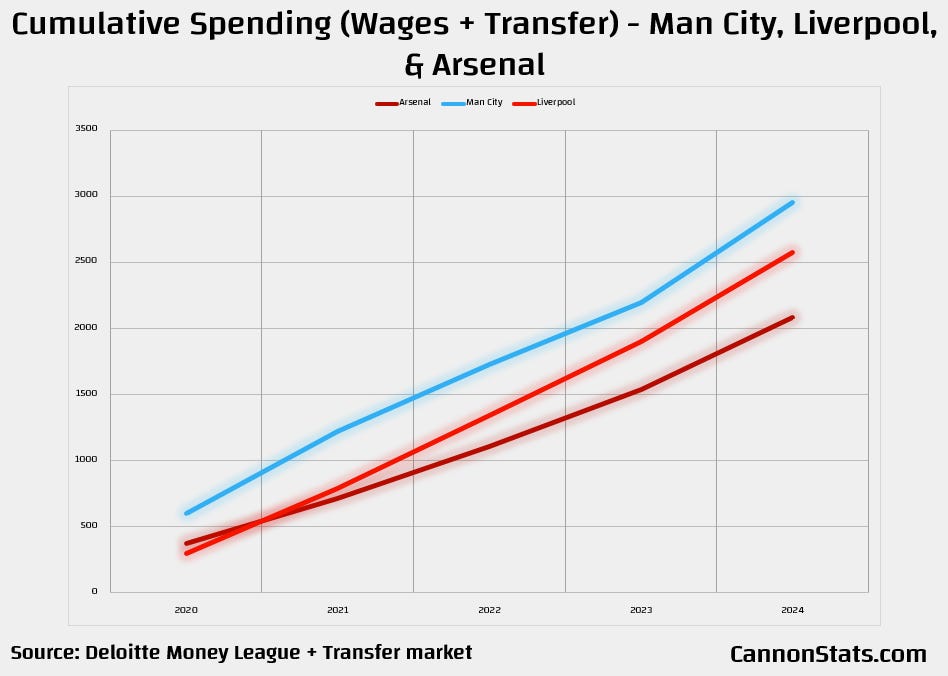
Nice analysis. I think our wages are still lower than ManU & Chelsea too?
The revenue numbers for top English clubs are affected by the Champions League. In 23-24, Arsenal (and ManU) were in the CL, and Liverpool was not. In 24-25, Liverpool and Arsenal are in the CL (and ManU is not). I anticipate that the 24-25 revenue numbers will sadly show Liverpool above Arsenal and ManU because of that change—and it’s possible that ManU will trail Arsenal as well(hopefully). I do not say that to be pessimistic or unimpressed with Arsenal’s growth, but merely to reluctantly suggest that its going to be hard for Arsenal to finish above Liverpool in revenue if both (or neither) are in the CL.